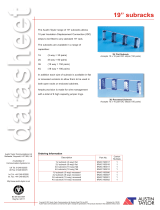Page is loading ...

10/01/2001 JPK
Instruction Manual
RT-740C-SL
Four Channel Video Transmitter

2
INSTALLATION AND OPERATION INSTRUCTIONS
INTRODUCTION
Thank you for purchasing your American Fibertek RT-740C-SL singlemode four channel video
transmitter. Please take a few minutes to read these installation instructions in order to obtain
the maximum performance from this product.
FUNCTIONAL DESCRIPTION
The RT-740C-SL operates as half of a transmitter / receiver pair for the transmission of four
channels of high performance 10 bit digital NTSC, PAL, RS170, or RS343 video signals. The
RT-740C-SL is designed to operate with the MR-740C-SL or RR-740C-SL video receiver over
one singlemode fiber optic cable.
The RT-740C-SL multiplexes four video input signals into a high speed serial data stream. This
serial data stream modulates a laser at 1310 nm wavelength. The 740C-SL Series product is
designed to operate over an optical loss budget range of 0 to 21 dB. Refer to the data sheets for
detailed performance specifications.
This unit is designed for rack mounting in any of the three American Fibertek subracks
available. The subrack model numbers are SR-20/1, SR-20R/1, and SR-20/2. Slide in rack
mounting and LED indicators provide for easy installation and monitoring of video and power.
The RT-740C-SL is designed for rack mounting only. For a modular stand alone version please
see the MT-740C-SL.
INSTALLATION
THE INSTALLATION OF THIS UNIT SHOULD BE MADE BY A QUALIFIED SERVICE
PERSON(S) AND MUST CONFORM TO ALL LOCAL CODES.
The unit slides into any open slot in the SR-20 subrack. Use a small screwdriver to push and
lock the two ¼ turn fasteners into place.
POWER SOURCE
Power to the unit is supplied by the subrack. Please refer to the SR-20 and PSR instructions for
further details.
POWER CONNECTION
Power is supplied to the unit via a four finger backplane connector. The RT-740C-SL can be
inserted into the subrack or removed from the subrack with power applied to the backplane.
FIBER CONNECTION
The fiber optic connection is made via a FC/PC connector located on the back of the unit. Be
sure to allow sufficient room for the required minimum bend radius of the fiber cable used.
VIDEO INPUT CONNECTIONS
The video input connections are made via BNC connectors on the right side of the unit. The
video input should be connected to an appropriate 75 baseband video source such as a
camera or a video recorder output. For optimum performance the video cables should be the
shortest length of coax practical.

3
RT-740C-SL STATUS INDICATORS
The RT-740C-SL transmitter provides the following LED status indicators described below to aid
in installation and troubleshooting:
VLI 1 THROUGH VLI 4
A bi-color LED indicator is provided for each of the four video inputs to the RT-740C-SL. DC
power and video status associated with each of these LED’s are summarized below.
Video Presence LED DC Power Status Video Status
Green On Proper Input Video Present
Red On Input Video Not Detected
Off Off Check Power Supply
OLI
This LED indicator is not used in this unit.

4
LIFETIME WARRANTY INFORMATION
American Fibertek, Inc warrants that at the time of delivery the products delivered will be free of
defects in materials and workmanship. Defective products will be repaired or replaced at the
exclusive option of American Fibertek. A Return Material Authorization (RMA) number is
required to send the products back in case of return. All returns must be shipped prepaid. This
warranty is void if the products have been tampered with. This warranty shall be construed in
accordance with New Jersey law and the courts of New Jersey shall have exclusive jurisdiction
over this contract. EXCEPT FOR THE FOREGOING WARRANTY, THERE IS NO WARRANTY
OF MERCHANTABILITY OR FITNESS FOR A PARTICULAR PURPOSE OR OTHERWISE,
EXPRESSED OR IMPLIED, WHICH EXTENDS BEYOND THE WARRANTY SET FORTH IN
THIS AGREEMENT. In any event, American Fibertek will not be responsible or liable for
contingent, consequential, or incidental damages. No agreement or understanding, expressed
or implied, except as set forth in this warranty, will be binding upon American Fibertek unless in
writing, signed by a duly authorized officer of American Fibertek.
SERVICE INFORMATION
There are no user serviceable parts inside the unit.
In the event that service is required to this unit, please direct all inquiries to:
American Fibertek, Inc. Phone: (877) 234-7200
120 Belmont Drive Phone: (732) 302-0660
Somerset, NJ 08873 FAX (732) 302-0667
E-mail: [email protected]
This unit complies with 21
CFR 1040.10 and 1040.11
/
